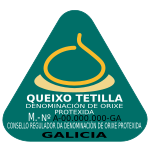Tetilla cheese facts for kids
Quick facts for kids Tetilla |
|
|---|---|
 |
|
| Other names | Perilla, Queixo da Illana |
| Country of origin | Spain |
| Region | Galicia |
| Source of milk | Cows' milk |
| Pasteurised | Yes |
| Texture | Soft, creamy |
| Fat content | >50% |
| Dimensions | 90 to 150 mm |
| Weight | 0.5 to 1.5 kg (1.1 to 3.3 lb) |
| Certification | DO 1993 DOP 1996  |
| Named after | Lua error in Module:Wikidata at line 70: attempt to index field 'wikibase' (a nil value). |
Tetilla is a special cheese from Galicia, a region in north-western Spain. It's made from cow's milk. This cheese is very popular in Galician cuisine and is often eaten as a dessert.
Contents
History of Tetilla Cheese
People have been making cheese in Galicia for a very long time. In the 1st century, a writer named Plinio talked about tasty cheeses from the area. Some people think Tetilla cheese might have started in a convent with nuns around the 11th century.
Galicia has always been a place with many cows. This meant there was plenty of milk for making cheese. Tetilla cheese was first made in towns like Curtis, Arzúa, and Melide. These towns are in the eastern part of A Coruña, near the border with Lugo.
Over time, cheese festivals helped make Tetilla cheese, and other Galician cheeses, more famous.
Special Certifications
Tetilla cheese has two important certifications:
- It received the Denominación de Origen (DO) certification in 1993. This means it's a special product from a certain area.
- It also got the European DOP certification in 1996. This is another special label from the European Union.
Tetilla is the most traditional cheese eaten in Galicia. It's also well-known and liked in the rest of Spain. About 2 million Tetilla cheeses are made each year. In 2010, they made the most ever, with 2.8 million cheeses!
What Makes Tetilla Cheese Special?
Tetilla cheese was first made in small towns like Arzúa, Melide, Curtis, and Sobrado dos Monxes. These towns are close to the border between the provinces of A Coruña and Pontevedra. Today, it's made all over Galicia.
How It's Made
This cheese is made using milk from three types of cows:
- Friesian cows
- Parda Alpina cows
- The local Rubia Gallega cows from Galicia
Shape and Size
The name tetilla means small breast in Spanish. This name describes the cheese's unique shape. It looks like a cone or half a pear. Because of its shape, it's sometimes called perilla.
A Tetilla cheese usually weighs from 0.5 to 1.5 kg. It has a diameter and height of 90 to 150 mm.
Aging Process
This cheese is aged for at least 8 days, but it can be aged for up to 30 days.
Taste and Texture
Tetilla cheese is soft and creamy. It has a smooth, ivory-white or yellowish color with only a few small holes. When you eat it, it feels very creamy in your mouth. It tastes natural and milky, with a little bit of sourness and a mild salty flavor. This makes it a cheese that most people will enjoy.
It's a great cheese for everyday meals. You can also use it in cooking, especially for stuffing or breading, because it melts well when heated. It tastes great with a glass of young red wine or an Albariño wine.
See also

- In Spanish: Queso de tetilla para niños

